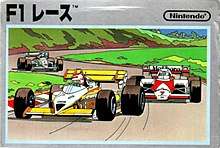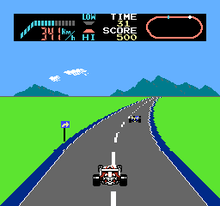F1 Race
F1 Race[lower-alpha 1] is a racing video game released in 1984 for the Family Computer in Japan. A version was released in 1990 for the Game Boy in Japan and in 1991 in Europe and North America, which included the Four Player Adapter for four-player gameplay.
| F1 Race | |
|---|---|
 Famicom version cover art. | |
| Developer(s) | HAL Laboratory |
| Publisher(s) | Nintendo |
| Designer(s) | Satoru Iwata |
| Composer(s) | Hideki Kanazashi |
| Platform(s) | Family Computer, Game Boy |
| Release |
|
| Genre(s) | Racing |
| Mode(s) | Single-player, multiplayer |
Gameplay

The game features racing in one of two Formula One cars around a variety of tracks near set in a landmark scenery. In the Family Computer version of the game, the cars come in three colors: red, light orange, and dark blue.[1]
Gameplay in the Family Computer version is similar to that of Namco's Pole Position. Finishing in first, second, or third results in a podium finish; players must win on each track to advance to the next. Vehicles in the game have a generic two-speed manual transmission governing their speed (with a "LOW" setting and a "HI" setting).[2] There are ten tracks in the race; the game repeats itself after the conclusion of the tenth circuit.[2] Three difficult levels help beginners to adjust to the artificial intelligence on "skill level 1" while novices get some extra challenge on "skill level 2" and experts get the ultimate challenge on "skill level 3.[2]" A strict time limit forces players to finish races without mistakes in order to progress to a more complicated race track. When the player's car come into contact with other cars, it will be destroyed and respawn, usually losing several seconds.
Several Nintendo characters appear at the end of race circuits for the Game Boy version: Mario, Luigi, Princess Peach, Toad, Bowser, Link, Samus, Pit and Donkey Kong. The game resulted in a Grand Prix series sequel, featuring Famicom Grand Prix: F-1 Race and Famicom Grand Prix II: 3D Hot Rally. Similar to the original, both games were never released outside Japan.
The Game Boy version has a considerably different gameplay compared to the original version, with longer race tracks set in different countries and new driving mechanics, as well as different game modes. The player is able to activate a temporary speed boost by pressing and holding up on the D-pad, this replaces the low-high gear setting from the Famicom version. In addition, the player is able to powerslide by continuing to hold left or right when turning sharp corners. Unlike the Famicom version, colliding with other cars no longer destroys the player's car and hitting an obstacle simply makes the car spin out.
Development and release
Development of F1 Race was handled by Japanese video game designer Satoru Iwata, alongside a small team at his company HAL Laboratory.[3][4] Production of the game began shortly after the completion of Golf, and was in development alongside several other Famicom titles such as Pinball, Mach Rider and Balloon Fight.[5] In a 1999 interview with Used Games magazine, Iwata recalled the game being a challenge to produce; F1 Race was the first Famicom game to feature raster scrolling, a feature that was not automatically built into the system, leading to him and his team having to program it from scratch.[4] It was developed based on Iwata's personal love for racing games, which would become influential in his later projects such as the Mario Kart series and F-Zero.[5] It was published by Nintendo and released in Japan on November 2, 1984.
A Game Boy version of F1 Race was published in Japan on November 9, 1990, in North America on February 3, 1991, and in Europe on October 10, 1991. The conversion was developed by Nintendo Research & Development 1 (R&D1) and designed by Naotaka Onishi, with music by Ryo Yoshiyoshi Ninohe and programming by Kenji Imai. Retitled F-1 Race, it allows for four-person multiplayer via the Game Boy Four Player Adapter.
Reception
| Reception | ||||||||
|---|---|---|---|---|---|---|---|---|
| ||||||||
GamesRadar ranked it the 49th best game available on the Game Boy and/or Game Boy Color. The staff called it a "first-class racing game" and praised its wide appeal to racing fans.[8]
Notes
References
- Images of F-1 Race for the Family Computer at Retro Game Zone
- Basic game summary at Xrea
- "『スーパーマリオ』が完成しても". Nintendo. 2009. Archived from the original on 31 March 2019. Retrieved 11 December 2019.
- "Satoru Iwata - 1999 Developer Interview". Shmuplations. Archived from the original on 14 September 2019. Retrieved 11 December 2019.
- "Iwata Asks - Mario Kart Wii - It Started With A Guy In Overalls". Nintendo. 2015. Archived from the original on 30 November 2019. Retrieved 11 December 2019.
- Cook, Brad (1998). "F-1 Race - Review". Allgame. Archived from the original on 14 November 2014. Retrieved 10 December 2019.
- Kai Kai (September 1990). Plus/consoleplus_numero001/Consoles + 001 - Page 139 (septembre 1991).jpg "F-1 Race Review" Check
|url=value (help) (in French) (1). Consoles Plus. Archived from the original on 10 December 2019. Retrieved 10 December 2019. - "Best Game Boy games of all time". GamesRadar. 2012-04-16. Retrieved 2013-12-05.